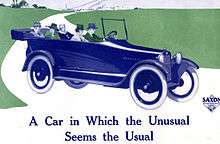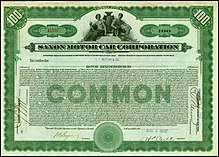Saxon Motor Car Company
The Saxon Motor Car Company[1][2] was located in Detroit, Michigan, from 1914 to 1922. In 1917 28,000 cars were made making it the seventh largest car maker in the United States.
.jpg)
.jpg)
4-cylinder Continental engine

6-cylinder Continental engine

The first car was a 2-seat runabout with 2-speed transmission and a 4-cylinder engine made by Ferro. 7000 were made in the first year of production. Electric lighting was added as a standard fitting in 1915. A six-cylinder car was added to the range in 1915 followed in 1917 by a Sedan. From 1918 the company got into financial problems and the 4-cylinder models were dropped from the range and the Sedan went as well in 1919.
In 1920 a new model, the Duplex, powered by an overhead-valve, four-cylinder engine joined the six-cylinder model and a sedan body rejoined the range. The six-cylinder cars were no longer listed after 1921 and production had fallen to 2100 cars.
The company moved to Ypsilanti, Michigan, where the cars were made in the Ace car plant, but this could not save the company and the last cars, probably made in 1922, were sold in 1923.
Band leader George Olsen drove a Saxon. Olsen mentions this on the first Jack Benny Program, May 2, 1932. Olsen was the bandleader on that show.
Notes and references
It has been misreported that Saxon President Harry Ford left the company due to illness. The fact is that after raising capital for the company, Ford lost his position in a proxy fight. He subsequently joined the war effort as an officer, and died while a military officer during the influenza epidemic.
- A brief history of the Saxon Motor Car Corporation is available on-line (in Spanish) at: http://www.autopasion18.com/HISTORIA-SAXON.htm .
Translation of the text on that Web page:Founded by Hugh Chalmers and Harry W. Ford (no relation to Henry Ford), the "Saxon Motor Car Company" was located in Detroit, Michigan. The idea of building the Saxon was conceived in 1912 by Hugh Chalmers,[1] whose"Chalmers car” (see “Chalmers Historia“) was among the most popular cars in the United States. Chalmers thought that consumers wanted a small car that was well made and economical. Finally, the Saxon car appeared in the late 1913. This first model, denoted "A", was a small car -- a two-seat roadster with a 4-cylinder, 1.4-liter engine designed by Ferro, built by Continental, which was watercooled and which developed 12 hp. The original gearbox was 2 speeds but was soon replaced by a 3-speed. The electric lights were optionally available at an additional cost of $70. This option eventually became standard in 1915. This car was sold at the price of a cyclecar and cost only $395, and although it was more like a cyclecar than a conventional car, its features realized the dreams of many people, so sales were high from the start. During the first year 3,000 units were produced. The power, speed and endurance of the Saxon roadster put it far beyond cycle car experiments of earlier years. Both the four-cylinder and the six-cylinder engines were built by Continental. Components of the roadsters and touring cars were of very high quality, with Timkin bearings, Rayfield carburetors, Wagner electrics and Atwater-Kent ignition systems. The engine of the Saxon was light, powerful, efficient, and durable. In 1914, a Saxon car traveled from New York to San Francisco in 30 days, which represented a real achievement for the time. During this journey of 6500 km, the Saxon traveled an average of 200 km per day and consumed an average of 12 liters per 100 km. In 1915, Harry W. Ford took over the company.[2] That same year the "Saxon Six" model appeared, which sold for $785. This model was followed in 1917 by a sedan. In 1916, Saxon's line included the "Saxon Model 14," with a 4-cylinder, 12 hp engine and the new "Saxon Model S-2" with a 6-cylinder, 20 hp. Continental engine. 1917,which had seen the 85R and S4T models introduced the previous year and during which 28,219 units were produced, was the best year for Saxon, which became the eighth largest producer of automobiles in the United States. However, Harry W. Ford fell ill and died at the end of year.[3] As production grew, the company's management decided to expand the facility by purchasing a larger factory. In 1918 the company started having financial problems. A miscalculation of the investment required for the new factory left the company undercapitalized. Four-cylinder models were eliminated from Saxon's line and the sedan model was also eliminated in 1919.[4] In 1919 the production was down to 3,426 units. In 1920 Saxon introduced a new model with a 4-cylinder, 45 hp, overhead valve engine. It was called the "Saxon Duplex" and was one of the most expensive cars of its class. In 1921 production fell to 521 units as the company suffered through the recession caused by World War I. Six-cylinder cars were withdrawn from Saxon's line and the Duplex engine was offered only in touring cars, sedans, and coupes. In 1922 the company was sold to the "Ace" factory and moved to Ypsilanti, Michigan, where production and sales continued, using the existing stock of Duplex engines. In 1923 the last cars were sold and the company went into bankruptcy late in the year.
[1] Hugh Chalmers was a former vice-president of the National Cash Register Corporation. In June 1908, he took control of the Thomas-Detroit car company of Detroit, Michigan, changed its name to the Chalmers Motor Car Company, and introduced a new model with a 30 hp. engine. [2] Notice of incorporation of Saxon Motor Company: “Saxon Motor Car Corp. Now,” The Automobile, vol. 33, page 984 (25 November 1915). Available on-line at: https://books.google.com/books?id=mMoqAAAAMAAJ&pg=RA1-PA984&lpg=RA1-PA984&dq=saxon&source=bl&ots=1iDOcijt4t&sig=0vs3cD0CfVLcr1d-Hs4I9h0keHU&hl=en&ei=0VgAS-CqI5DflAeC2YWSCw&sa=X&oi=book_result&ct=result&resnum=6&ved=0CBcQ6AEwBQ . [3] Obituary of Harry W. Ford: “Capt. Harry W. Ford,” New York Times, 19 December 1918. [4] Notice of financial problems of Saxon Motor Car Corp.: “Solution of Saxon Finances Probable,” Motor Record, vol. 6, page 24 (October 1919). Available on-line at: https://books.google.com/books?id=A8knAAAAMAAJ&pg=RA3-PA24&lpg=RA3-PA24&dq=saxon&source=bl&ots=Yomqo4vsg2&sig=AxfFAzAYwc2__XYwRx7xQ2YzeIo&hl=en&ei=R1oAS5jhPM2ylAee7YWaCw&sa=X&oi=book_result&ct=result&resnum=4&ved=0CBEQ6AEwAzge . - Ron McGown, "1915 Saxon," Australian Classic Car, pages 26-29 (April 2008). Available on-line at: "Archived copy" (PDF). Archived from the original (PDF) on 2009-10-08. Retrieved 2009-11-23.CS1 maint: archived copy as title (link) .
External links
| Wikimedia Commons has media related to Saxon automobiles. |